Humans to Draw on for Fashion Printable
Drawing Anatomy for Beginners, Learning the Ins and Outs
When it comes to learning how to draw people successfully, knowing human anatomy is key. Jeff Mellem, artist and writer of How to Describe People , shares the top dos and don'ts of drawing anatomy for beginner artists so you tin start cartoon more than realistic figures in no fourth dimension.
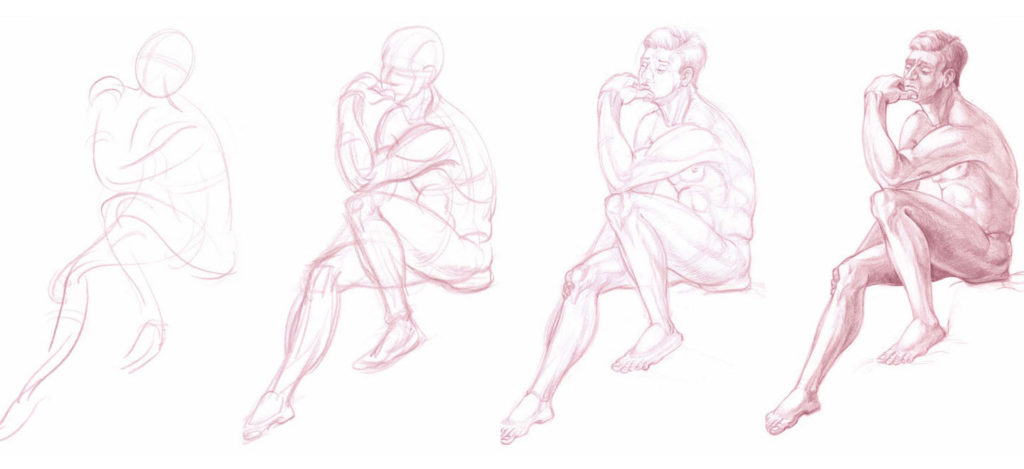
Figure Drawings excerpted from "How to Draw People" past Jeff Mellem
Learning to Draw? Check Out Our Live Video Series, Drawing Together!
Learn to describe people, body parts, and much more in our live weekly video series.
How to Depict an Arm How to Draw a Skull
How to Draw a Foot How to Draw a Hand
Join the Adjacent Live Lesson
1. DON'T call up like an anatomy book
Drawing anatomy for beginners tin can experience overwhelming at first because there are and so many muscles on the body. When you lot're looking at a model and you encounter a lot on bumps, you might be tempted to pull out an anatomy book to decipher what'due south going on under the skin.
An anatomy volume is neat at telling yous what you lot're looking at but it'southward not very helpful at telling y'all the iii-dimensional shape of the muscles.
DO recall in unproblematic volumes
When you first arroyo figure drawing, y'all demand to start out with establishing the basic volumes of the figure using spheres, boxes, and cylinders. By only first with these bones shapes and so building up the complexity as you go along, you lot will be able to make your drawing maintain its sense of dimension.
If you re-create contours before you lot build in the construction, I guarantee yous'll terminate upwards with a flat-looking drawing.
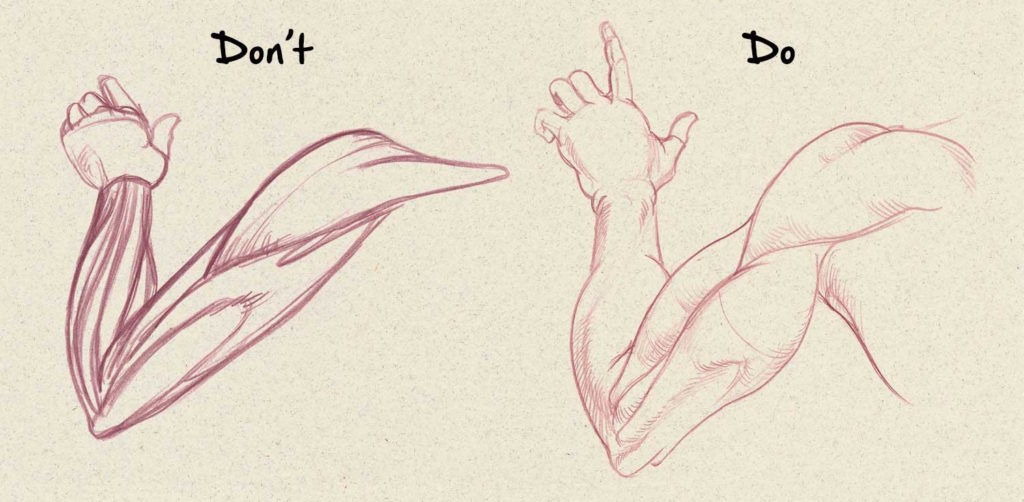
The drawing on the left overemphasizes the model's muscles and it looks more similar an anatomy book than a effigy. An creative person needs to recollect virtually the 3D shape of the muscles to give the figure an illusion of volume.
The Takeaway:
Use an anatomy volume to sympathise what'south below the surface but think virtually each musculus in 3D. Don't depict the muscles as a series of lines. Draw them as sculpted spheres, boxes and cylinders.
With that being said, yous don't ever take to actually depict spheres and boxes on the page. If you wait at an creative person like Harry Carmean, you lot can meet that while he sometimes is merely cartoon counters of the body, he is conspicuously thinking well-nigh the 3D qualities of what he'due south drawing.
Video Lesson: How to Draw an Arm
In this episode of our weekly Cartoon Together serial, creative person Scott Maier shows how to draw an arm.
2. DON'T make muscles the focus
When artists first start paying closer attention to adding anatomy to their drawings, they often have a tendency to overemphasize the beefcake. The figures often end up looking similar they have no pare. The muscles are there to add more realism to the figure, just they shouldn't exist the focal point of the cartoon.
DO use muscles to reinforce the activeness
The focus of a drawing should convey an activity, an emotion or the bailiwick'due south personality. You lot don't want a viewer to terminate and look at the parts of your drawing; you want the viewer to come across the whole figure and be interested in what that effigy is doing and who he or she is.
In order to maintain focus on the action it's always a great exercise to start all your drawings with a gesture cartoon. A gesture drawing serves as a blueprint for the activeness. Everything that comes after is to assistance clarify and enhance that action.
The muscles should be drawn to amplify the motility of the figure and shouldn't draw attention to themselves. A proficient example of this is comic book characters that take exaggerated anatomy to convey their forcefulness.
A successful comic book page isn't nigh the graphic symbol'due south muscles but nigh how that character's power is beingness expressed in the story. The volumes of the muscles are designed to pb the centre through the trunk toward a point of activeness. The reader isn't stopping to look at the grapheme'due south well-adult musculature.
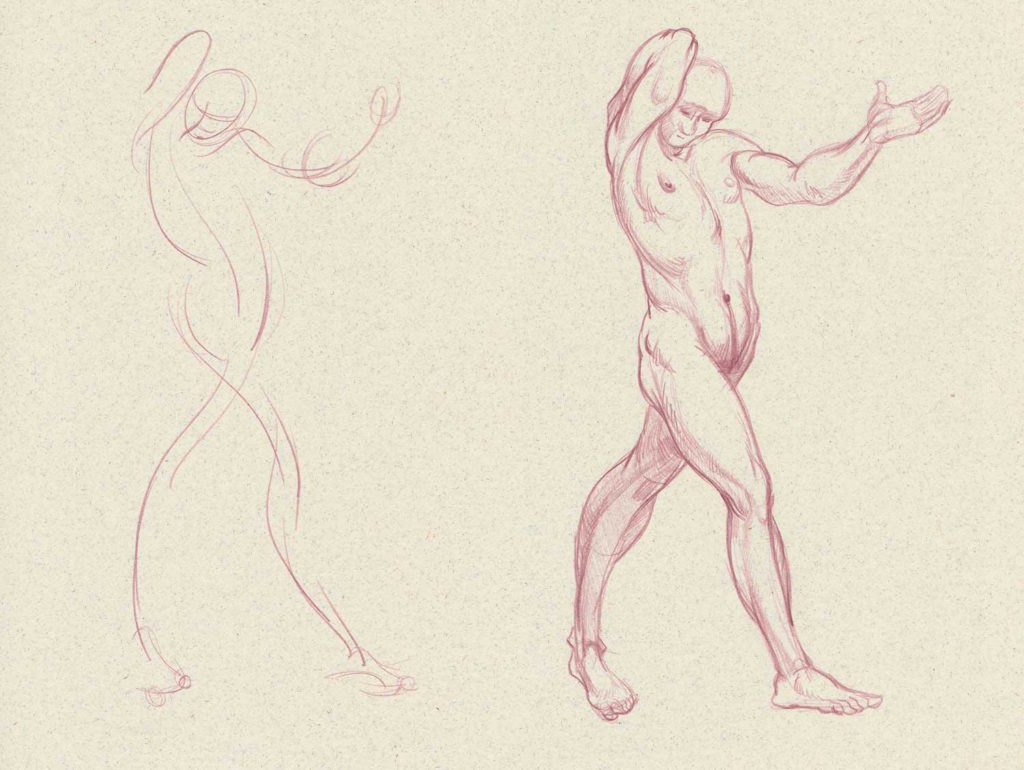
Notice how the muscles in the figure on the right reflect the gesture drawing on the left. The muscles are used to reinforce the effigy's action, they aren't the focus of the drawing.
The Takeaway:
Anatomy is there to add realism but it's less important then carrying the action and attitude of the whole figure.
3. DON'T describe every figure with the same shapes
When artists offset using basic shapes to develop figures they often start to fall into a design of using the aforementioned shapes to build every figure.
DO observe and accommodate to your figure's unique build
When you lot're building your figure y'all accept to look and adapt your shapes to the specific subject you lot're drawing. You're not going to use the aforementioned shapes for a bodybuilder that you would a sumo wrestler or a long altitude runner.
You have to look at your subject and figure out what simple shapes are the all-time tools to develop your figure. For example, some people take very squarish heads which needs to be constructed from box shapes while others have a more roundish appearance that should be built from spheres.
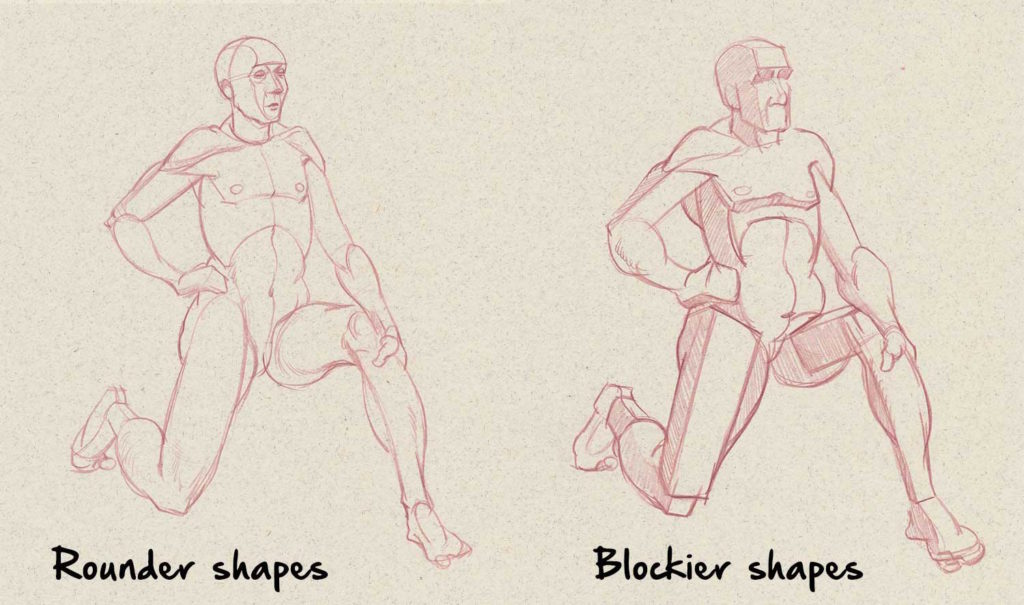
These ii figures are in the same pose simply are built from unlike shapes. The figure on the right is built from more cake shapes and it gives the figure a sturdier feeling.
The Takeaway:
Don't approach every effigy with a formula. Instead, detect and accommodate your shapes to fit your subject.
Figure Drawing Essentials: Anatomy & Form
Artist Brent Eviston shows how to draw the effigy with individual exercises designed to assistance y'all build foundational skills. Download the full video for more instruction on drawing anatomy.
4. DON'T re-create what you run into
If you only copy what you see you lot will never create what you imagine. I never saw the bespeak of replicating a photo in a drawing beyond beingness an exercise to build observational skills. Why indistinguishable what already exists when you tin translate and adapt every bit yous see fit?
Exercise recreate what y'all see on the page
Observational skills are important but not but for copying what y'all see. Apply your observational skills to clarify your subject field'southward unique shapes so you tin reinterpret information technology on the page. That means you aren't copying counters of the body. Instead you're recreating a figure on the page from the ground up.
You lot start by capturing its movement in a gesture, rebuild the figure iii-dimensionally using basic spheres, boxes and cylinders, and then sculpt those simple shapes into anatomical forms. This is a very different process than just replicating what yous see.
You're combining what you see with your 3D knowledge of anatomy to recreate the figure on the folio. This will not only help you to develop drawing that have a sense of mass just also volition allow you lot to adapt and change the figure to create something new.
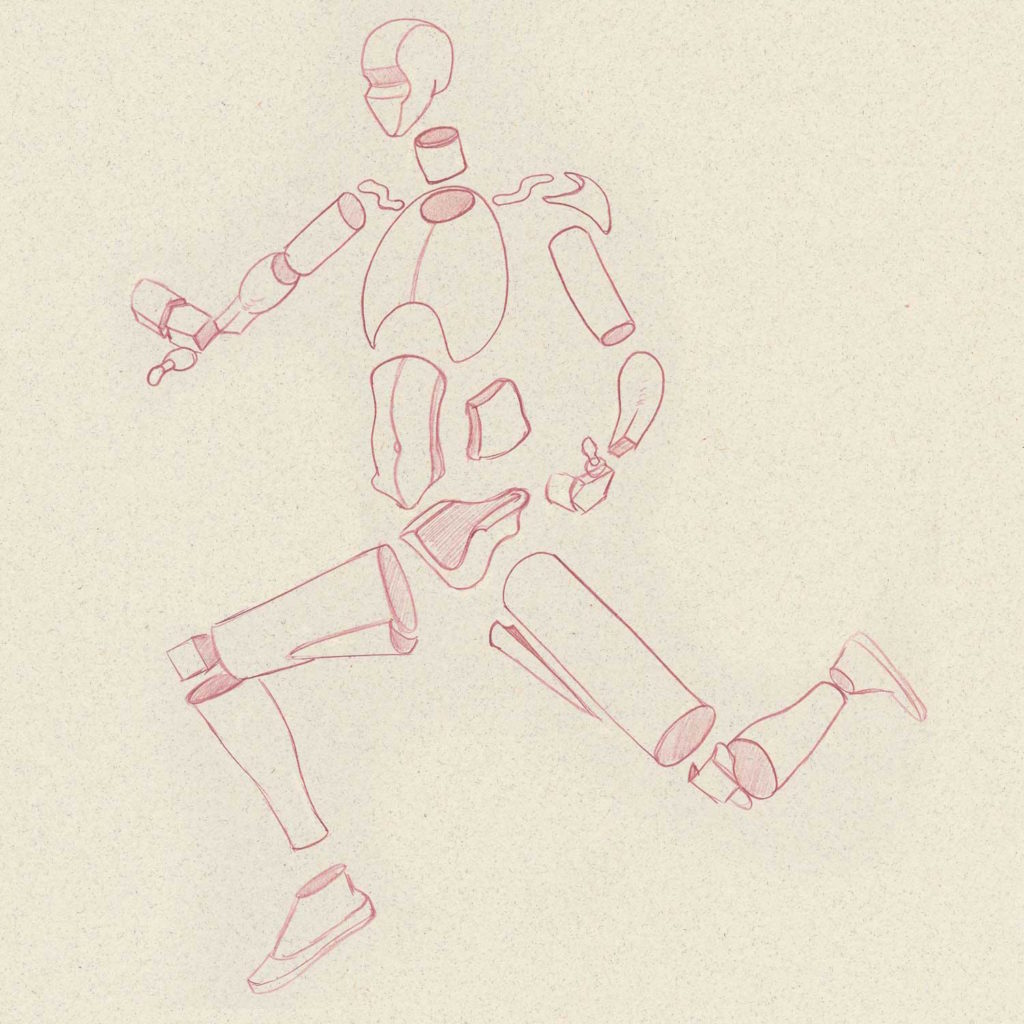
This is only a fun drawing to help illustrate that you need to understand the 3D shapes of a figure and and so y'all can reassemble them on the page. This is a different manner of thinking than simply copying the contours you see.
The Takeaway:
The chore of an artist isn't to replicate what he or she sees. It is to interpret what he or she understands. When drawing a figure, you bring in your knowledge of anatomy and book to draw a figure rather than just copying contours and values.
5. DO pay attention to proportions and anatomy
To draw a realistic figure, you need to pay attention to accurately capture the figure's proportions and anatomy. This comes from both studying beefcake and having skillful observational skills.
DON'T exist overly rigid.
Anatomy and proportion are important. But alone, they don't make for an interesting drawing. A effigy cartoon that feels similar it has personality or appears dynamic is going to be more interesting than one that is technically right.
Permit the anatomy and proportion take a supporting role to the underlying gesture drawing. Every step of your cartoon should be to create a unified figure that has energy and attitude even if that means altering the effigy's proportions or beefcake to better emphasize that action.

This figure has exaggerated proportions – like to those used in mode drawing. Information technology doesn't matter that it'southward non correctly proportioned if the determination to exaggerate is purposeful. You can find many examples of artists who distort and exaggerate proportions for stylistic reasons.
The Takeaway:
Cartoon corking anatomy helps artists create realistic-looking figures that appear to have bodily mass and volume. Nonetheless, the beefcake needs to add to the sense of motion of the effigy and not distract from it. You must have the skill to be able to draw the muscles in 3D in society to modify and conform the shapes and emphasize the move and personality of your subjects.
More Resources on Drawing Anatomy and Figures
three Mistakes You lot Make When Drawing the Figures
Figure Cartoon Methods of the Masters Cartoon Dynamic Human Figures
Train Your Eye With Figure Sketching 5 Figure Drawing Tips





0 Response to "Humans to Draw on for Fashion Printable"
Post a Comment